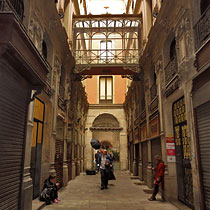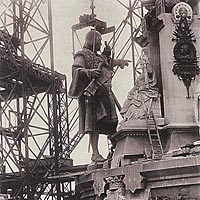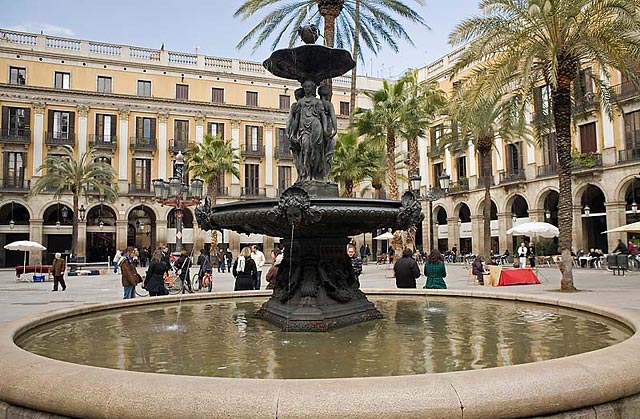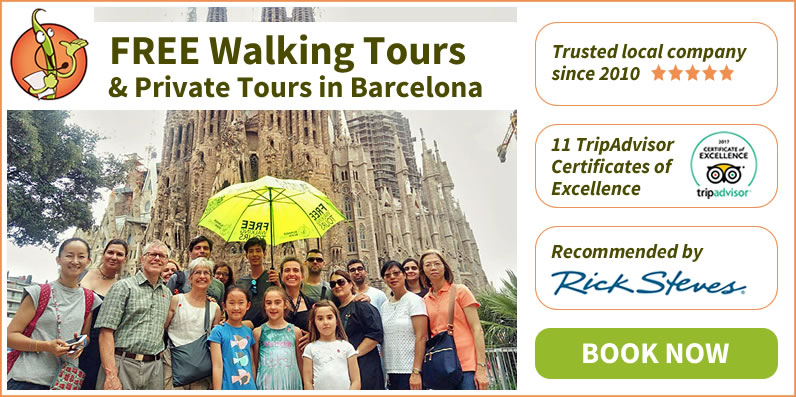This is the last part of a walking tour that brought us from Plaça Catalunya through Pla de la Boqueria. Today we will end up at the Columbus Monument, that old sailor who has some stories to share about Barcelona. Join me on the last stretch of our adventure down La Rambla.
Continuing on from Liceu Theatre to your left you will see the entrance of the Neoclassical Plaça Reial, the meeting point for our free tours. Once the site of a convent for the Caputxin order of Barcelona, this place has seen many changes throughout its history. Look above the entrance facing La Rambla and you will find statues of Indian children and portraits of many famous explorers of the Americas. The whole place was designed as an homage to the Catholic Monarchs, Isabella and Ferdinand, and their achievements (hence the name, Royal Square). At its centre, an equestrian bronze statue of King Ferdinand was planned but never put in place. Instead, today, we see the work of another important Barcelona citizen: Antoni Rovira i Trias and his Fountain of the 3 Graces.

If the old rusty gate is open, you can leave the square through Passatge the Bacardí, on the Southern corner. This 1856 covered shopping gallery was the first of its kind in Barcelona, named after the tycoon who owned the block: Ramón Bacardí (don’t confuse him with another famous Catalan related to the rum business). The passageway seems somehow abandoned now but the dust on the walls still talk of a bygone era and make it that bit more special.
Teatre Principal is the name given to the building with a curved façade that you will find on your right as you walk towards the sea. This forgotten space is actually the oldest theatre in Barcelona. In 1579 King Philip II gave exclusivity of theatre plays to the Santa Creu Hospital as a way of financing themselves. The original structure is not here anymore and the one you can see today dates from the 18th century. It changed the name to Teatre Principal (main theatre) when a competitor appeared: the Liceu, further up the boulevard. They still have something in common though: both were destroyed by fire twice!
The statue you can see on a pedestal in front of the theatre is Frederic Soler “Pitarra”, a 19th-century playwright and poet who created the famous verses: “Al Fossar de les Moreres no s’hi enterra cap traïdor; fins perdent nostres banderes serà l’urna de l’honor” (“In the graveyard of the mulberry trees no traitor shall be buried; even if our flags are lost, it will be the urn of honour”). These lines pay homage to the defenders of Barcelona city during the siege of 1714. You have to walk for about 10 minutes towards El Born to reach that graveyard he talks about.

This small square marks the last section of the boulevard: Rambla de Santa Mònica, also known as Rambla dels Gossos (Dogs Rambla) in the old times. If you think there are a lot of these animals in Barcelona now, this is nothing compared to the problems the City Council had with them in the 18th century. Gypsies were even invited to kill as many stray dogs as they could in order to fix the problem of an overgrown canine population. Here is where all our furry friends came to sleep at night thus creating its nickname. An old tale of the city tells of a chemist commissioned by the Town Hall to produce a tasty poisoned treat for the dogs. Something went wrong though as, instead of the deadly toxin, the man created a laxative. The following morning, a carpet of dead dogs was expected. However, a nasty surprise coated the pavement instead!
In Paris, they have an Arc de Triomphe and Wallace Fountains but in Barcelona, we have them too… and we like them better. 12 of these fountains were donated to the city in 1888 and 2 of the authentic ones are still standing. Are you getting thirsty? Well, you are just looking at one of the originals but you can discover replicas all over Barcelona. Each one with a different dispensing method. In some, the waterfalls in between the 4 caryatids that hold the roof so you will need a glass to have a drink. Travel to places as far away as Brazil, Canada, Italy or Israel and you might stumble across some more.

And here we are, at the end of La Rambla. The medieval shipyard that built the big galleons used in Catalonia’s Mediterranean campaigns (the most magnificent of its kind in Europe and now the Maritime Museum) is at the bottom on the right. But let’s meet the man that discovered a new trading route in the Atlantic which started the decline of Barcelona’s Mediterranean wealth: Mr Christopher Columbus. The Columbus Monument was erected in 1888. The city was going through an economical boom thanks to textile industries, slave traders and Universal Exhibitions. And no, he is not pointing towards America. Maybe because he died not realising a new continent had been discovered or maybe because, after all, this is the direction of the sea in Barcelona.
That is all for now. I hope you enjoyed this walk as well as part 1 and part 2. There are many more things I would love to share with you about La Rambla but that will be done some other time.
Photograph by Gorka Regidor











Thank you for this wonderful description.
I am looking at your guided tours and very interested. But shy of taking on something that does not have a set price.
Can you give me a guide as to the price?
Hi Pauline,
I am glad you enjoyed the article. About your query, we offer different types of tours, from private tours to scheduled fixed price tours to free walking tours. If you are referring to the free tours, they are based on donations so you can give the guide at the end as much or as little as you’d like depending on your satisfaction.
I hope it helps. Looking forward to seeing you soon in Barcelona 🙂